This Kraken wallet review offers a deep dive into the native multi-chain and non-custodial wallet from one of the most popular crypto exchanges. You can send, receive, and swap cryptos and NFTs on the Kraken wallet and link it with your Kraken exchange account for quick transfers.
The wallet is designed with both beginner and experienced crypto traders in mind, and it even provides access to various dApps and the option to stake for additional returns.
This sounds great, but is it worth using a Kraken wallet in 2025? We explore everything you need to know here.
What is Kraken Wallet?
Kraken wallet is a non-custodial multi-chain wallet developed by Kraken, one of the most reputable cryptocurrency exchanges globally.
Jesse Powell and Thanh Luu built Kraken in 2011 as a secure platform to trade cryptocurrencies—it’s now number one on Forbes’ list of the best crypto exchanges in 2025.
Over the years, the platform has introduced advanced trading options, like margin trading and derivative trading, and in 2020, Kraken became a regulated financial institution.
This was after it became the first U.S. crypto exchange to be given a Special Purpose Depository Institution (SPDI) charter in Wyoming. This helped it bridge the gap between crypto and traditional banking by offering more secure and compliant services.
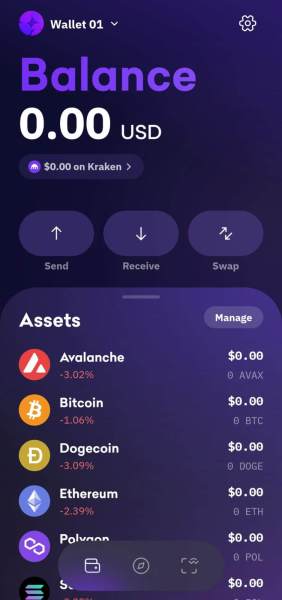
Fast forward to April 2024, when the Kraken wallet was launched to help traders easily swap, receive, and send cryptocurrencies across eight blockchains.
Naturally, due to the integration between the wallet and exchange, it has become the default choice for traders who already use the Kraken exchange. However, you don’t necessarily need a Kraken exchange account to use the Kraken wallet.
How Does Kraken Wallet Work?
With a Kraken wallet account, you get full control over your private keys, and therefore, your assets—plus, you don’t need to hand over your crypto custody or personal info to a third party.
As noted above, the Kraken wallet is also multi-chain, so you’ll enjoy access to cryptocurrencies on various networks – no need to switch between wallets to manage different assets.
Furthermore, the linked ecosystem is a key benefit for anyone looking for seamless, quick fund transfers and advanced trading tools.
That’s because the Kraken Wallet isn’t just compatible with the centralized exchange, but also Kraken Pro — an advanced cryptocurrency trading platform with detailed analytics, complex orders, and a comprehensive trading interface.
Kraken Wallet Pros and Cons
Here’s a quick look at Kraken Wallet’s pros and cons to give you a balanced view of the app.
Pros
- ✅ Seamless transfers between Kraken Wallet and Kraken Exchange accounts.
- ✅ Intuitive design that caters to both beginners and experienced traders.
- ✅ Multi-layered security features like encrypted keys, SOC compliance, and cold storage.
- ✅ Compatibility with various decentralized apps in the Web3 space.
- ✅ No KYC needed if you don’t connect to the Kraken Exchange.
Cons
- ❌ Only supports 8 blockchains, fewer than rivals like OKX.
- ❌ Has fees for certain transactions (i.e., moving assets off the Kraken platform).
- ❌ The Kraken wallet isn’t fully available in all regions.
Kraken Wallet’s Key Features
Still on the fence? While Kraken is known to be one of the best crypto wallets, it isn’t for everyone. Here’s a closer look at the wallet’s best features to help you decide if it’s for you.
Multi-Chain Support
As we’ve briefly mentioned in this Kraken wallet review, Kraken lets you access eight blockchains: Bitcoin, Ethereum, Dogecoin, Solana, Arbitrum, Base, Optimism, and Blast.
As you can see, Kraken covers almost every single widely used network, which is exactly what we expect from a top crypto wallet.
You can buy and store over 2,000 cryptocurrencies across these blockchains, and that, too, from one intuitive interface. Say goodbye to juggling multiple wallets, apps, and addresses.
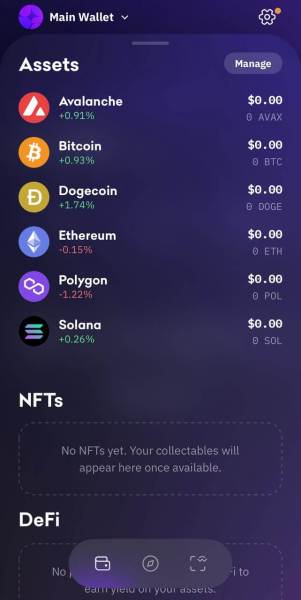
Irrespective of whether you’re swapping tokens, exploring new blockchains, or tracking balances, you won’t have to exit the Kraken wallet. This way, Kraken streamlines crypto portfolio management and simplifies and speeds up cross-chain activity.
That said, while Kraken covers the essentials, it does lag behind the competition in terms of sheer blockchain support. For example, Trust Wallet supports over 65 blockchains and allows users to store over 250K cryptocurrencies and tokens.
There’s also Best Wallet, a hot new free crypto wallet, which aims to capture over 40% of the non-custodial wallet market by building up support for over 60 blockchains. Check our full Best Wallet review to see how it compares to Kraken.
➡️Related Read: A Full Best Wallet App Review for 2025
Non-Custodial Wallet
Another major feature of the Kraken Wallet is that it’s non-custodial. Essentially, you’ll be the only one with access to the private keys of your wallet. This puts the control of your account in your own hands – you won’t have to rely on third-party security measures.
When you sign up, you’ll get 12 words, or recovery phrases, which you’ll need in case you lose access to your account.
Custodial wallets differ because the provider holds the private keys. So, if you lose access to your account, they can help you recover it.
For example, a crypto trader accidentally flashed his recovery phrases on a YouTube livestream. He lost all his funds almost immediately, as someone used it to access his account.
Integration with Kraken Exchange
It wouldn’t be a stretch to say that those who have heard about Kraken know it primarily as a cryptocurrency exchange. It’s among the top 15 exchanges, with an average daily volume of $2B+.
If you happen to be a Kraken exchange user, buying, selling, and trading crypto on it, you’ll be glad to find out that you can seamlessly link it with the Kraken Wallet.
It’s worth noting that the Kraken exchange supports other wallets, too. However, in that case, you won’t enjoy Kraken’s seamless, near-instant bridging between exchange trading and self-custody.
The Kraken wallet is ideal for users already trading on Kraken who want to store their assets securely without leaving the exchange.
Access to DeFi Apps
Once you install the Kraken app, you’ll see a lot of dApp features on the ‘Explore’ section. You can access these directly from your wallet, including popular ones like Aave and Uniswap.
We also found a lot of NFT marketplace apps, which let you seamlessly access and trade digital assets beyond cryptocurrencies.
For instance, you can access OpenSea, one of the largest NFT markets for assets like art, music, and collectibles. This makes it easy to spend and manage crypto on NFTs directly from the Kraken Wallet app.
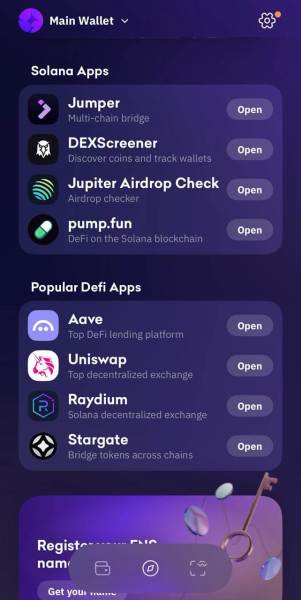
Additionally, the Kraken Wallet comes with other handy tools, such as CoinGecko and Revoke. These will help you research the broader crypto market to identify the best cryptos to invest in.
For instance, CoinGecko is a data aggregator where you can get info on current prices, market depth, and the latest news on millions of cryptocurrencies.
Overall, Kraken’s crypto wallet app acts as your one-stop solution to the world of decentralized finance and crypto.
Advanced Trading Features
If you’re a professional trader using Kraken Pro to buy and sell various crypto coins, then you can integrate it with the Kraken Wallet. This is very similar to the native Kraken exchange integration, and will make it easier and quicker for you to transfer funds to and from your Pro account.
Kraken Pro, in case you didn’t know, is meant for frequent, high-volume traders. Beyond lower transaction costs, it also offers professional charts and new-gen trading tools.
By linking it with the Kraken Wallet app, you can access more sophisticated trading options, including margin trading, directly from your wallet.
Staking Options
Not only can you buy and hold crypto on the Kraken Wallet, but you can also stake to earn additional rewards. Here are your options:
- Flexible staking — You can trade with the staked assets, withdraw them, or use them as collateral.
- Bonded staking — Your assets are locked up for a specific time period (for example, 3 days or 21 days), often offering a higher APY than flexible staking.
Annual Percentage Yield (APY) is the annual return you get on staking crypto on a compounded basis. This means that if you stake $100 for the first year at 10% APY, you’ll earn $10. Then, for the next year, this $10 will be auto-invested and you’ll earn interest on $110 for the second year.
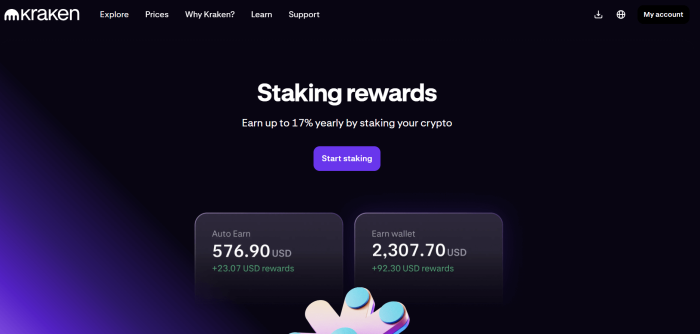
We also found that Kraken supports $ETH restaking. This is powered by EigenLayer – a new protocol that lets you re-stake your $ETH (which you’ve already staked once) to secure dApps.
This helps you maximize your capital while earning additional rewards in the form of $ETH, $EIGEN, or other ERC-20 tokens. So, if you believe in the HODL philosophy, you might as well use your idle assets to earn additional rewards with Kraken.
For instance, if you hold Bitcoin, Kraken would be the best Bitcoin wallet to pledge your allegiance to the ‘digital gold’ while still using it to churn out some passive income.
Kraken Wallet Pricing Breakdown
| Type of Fee | Cost |
| Network Fees | $1-5 ($15-20 during peak hours) |
| Withdrawal Fees | 0.00001 $BTC or 0.00012 $ETH. |
| Deposit Fees | Free (only pay network fees) |
You don’t need to pay anything for creating an account on Kraken and using the app is completely free, too. However, just like other crypto wallets, you’ll need to pay network fees, including gas fees, while sending or swapping cryptocurrency on Kraken Wallet.
It’s worth noting that the network fee will depend on the traffic congestion at the time of swapping or sending. During peak hours, it can be as high as $15-$20.
At other times, though, you can expect a fee of around $1-$5. On layer-2 networks like Arbitrum or Optimism, the fee is much lower, often less than a dollar. If you’re withdrawing crypto from the Kraken exchange to the Kraken Wallet, you’ll pay a withdrawal fee, which varies from asset to asset.
For example, the withdrawal fee for Bitcoin is 0.00001 $BTC, while the fee for Ethereum is 0.00012 $ETH. You’ll find the complete list of the withdrawal fees on the Kraken website.
On the bright side, deposits on the exchange are totally free, so you only have to pay the network fee while transferring funds from the wallet to the exchange.
Kraken Wallet’s Security
Kraken has adopted a comprehensive approach to protect both your funds and any personal information you share with them. Here are some of its best security features.
Proof-of-Reserves Audits
Kraken goes through regular independent third-party Proof-of-Reserves (PoR) audits to establish trust and transparency. PoR helps users verify that the wallet provider actually holds the asset it claims to hold on your behalf. For Kraken, you can readily verify the results on LedgerLens.
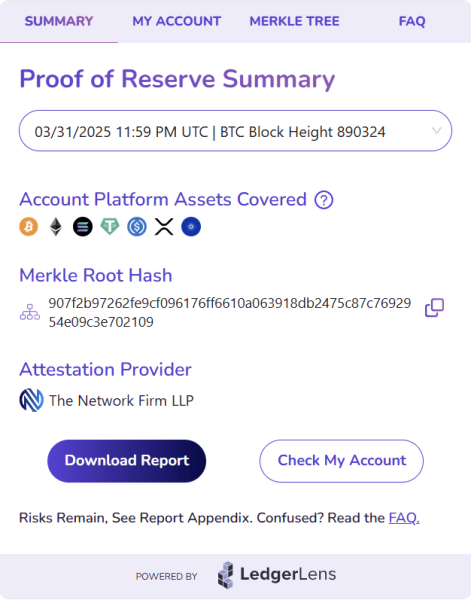
Kraken Wallet currently maintains a 114.9% reserve ratio for $BTC, a 102% reserve ratio for $ETH, and 201.5% for $USDC. As the numbers suggest, Kraken holds more assets than it currently owes to its customers, which is always a good sign.
Data Encryption
All personal data Kraken collects is encrypted at both the data and system levels. The wallet is also ISO/IEC 27001:2013 certified and has completed a SOC 2 type 1 examination.
- ISO/IEC 27001:2013 is a security standard that ensures an organization follows a systematic approach to managing sensitive information.
- SOC 2 type 1 certification ensures that the risk controls placed by Kraken are designed effectively to mitigate vulnerabilities.
You can rest easy knowing Kraken has adequate security measures in place to identify and manage privacy risks and protect your personal information from getting leaked into the wild.
In this blog post published in June 2025, Kraken claims its security controls have been audited by an independent third party, and that they passed with flying colors. Note that this information isn’t yet verifiable, as Kraken hasn’t published or linked to the audit.
2FA and Biometrics
Kraken also employs Two-Factor Authentication (2FA) for an added layer of security. This means that you (or anyone else) cannot access your Kraken Wallet account with just your password.
You’ll be required to go through an additional identity verification, which can be through third-party apps like Google Authenticator or Microsoft Authenticator.
Also, when you set up your wallet, you’ll be prompted to enable biometric verification, where you can use Face ID or your fingerprint to access your wallet.
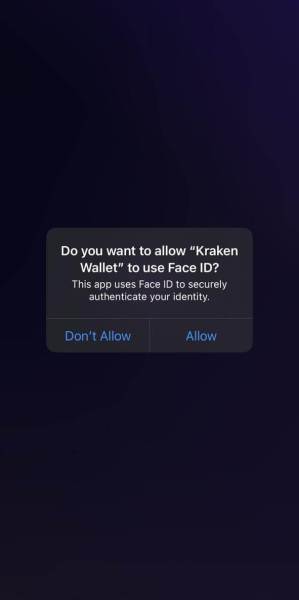
Other Security Protocols
Besides these essential security measures, here are some other security protocols employed by Kraken to keep you safe:
- Global Settings Time Lock — This disables changes to sensitive settings such as withdrawal address or 2FA details for 24–48 hours. It’s handy if your wallet has been compromised and the attacker attempts to change these settings to lock you out.
- Email Confirmations for New Withdrawals — This feature introduces mandatory email confirmation for adding new withdrawal addresses. It ensures that no one other than you can request to send your crypto to new wallets.
Overall, Kraken’s security is on par with that of other leading wallets and exchanges and has never experienced breaches that have impacted customer data or funds.
They’ve had the odd incident with a zero-day exploit, but the platform proved it can handle security emergencies within minutes.
Kraken Wallet Interface – Is it Easy to Use?
We found the Kraken Wallet pretty easy to use with its intuitive design and interface, regardless of your experience with crypto wallets.
Plus, the app is clean with a ‘dark purple’ theme, which gives off a futuristic, almost Cyberpunk 2077 vibe. You’ll find various options at the top of your app, where you can send, swap, or receive crypto.
The ‘Explore’ section is rather interesting. It offers access to various apps, including DeFi and staking platforms.
- For Beginners: The wallet is intuitive and easy to navigate, making it a good choice for those new to the crypto space.
- For Experienced Traders: The wallet offers integrations with the Kraken exchange and Kraken Pro, offering access to all sophisticated trading tools and options in one place.
Stuff like transaction fees might feel like minor challenges, since they keep fluctuating as per network traffic, and there are no clear fixed charges.
That said, it’s actually on par with other crypto wallet apps around. Kraken doesn’t charge anything above the network fee and is pretty transparent with its fee structure.
Plus, there are a lot of tutorials on the Kraken website, which will help you through whatever learning curve is there, though it’s not much at all.
How Does Kraken Compare to Other Crypto Wallets?
Here’s a short and crisp table comparing Kraken Wallet with other industry leaders. Our goal here is to help you quickly identify a wallet that fits your needs.
| Wallet | Top Choice For | Standout Features |
| Best Wallet | Access to multiple blockchains and pre-market meme coins | – Launchpad with vetted early-stage meme coins – 60+ blockchains, integrated DEX swaps, and cross-chain bridges – Fireblocks MPC security tech |
| Kraken Wallet | Kraken exchange users | – Multi-chain access – Centralized exchange integration – NFT marketplace and dApps access |
| MetaMask | Ethereum users and Web3 enthusiasts | – Extensive dApp support – Hardware wallet support – Customizable |
| Trust Wallet | Crypto beginners | – Access to 70+ blockchains – Built-in Web3 Browser – NFT support |
Kraken vs MetaMask: Which is Best?
Right off the bat, MetaMask isn’t a multi-chain wallet like Kraken. At the time of writing, MetaMask only supports Ethereum and other EVM-compatible assets (like $BNB and $MATIC).
However, with Kraken Wallet, you can access multiple blockchains, such as Bitcoin, Ethereum, and Solana. Secondly, while it’s still non-custodial, Metamask works as a browser extension.
So, your private keys are stored on the browser, which isn’t entirely safe. If your device is compromised (say, during a phishing attack), you risk losing your account and the funds therein.
However, if you have a Metamask wallet that you wish to connect to your Kraken exchange account, there’ll be a waiting period for fund transfers, which can slow down trading.
That said, if you need a wallet primarily for interacting with dApps and Web3, Metamask is a better pick since it’s currently better optimized and supports more dApps than Kraken Wallet.
Kraken Reputation – What Are People Saying?
Users have had mixed experiences with the Kraken Wallet. While for some, it’s an easy-to-use, beginner-friendly wallet, others have complained about slow transactions and fund withholding.
However, we noticed that many of these complaints were due to the lack of knowledge of how the broader crypto market works, instead of a fault on Kraken’s end.
For example, some users don’t complete their KYC verification on Kraken, but then complain about withdrawals not being processed. Per Kraken’s terms and conditions, you must complete KYC before transacting on the wallet.
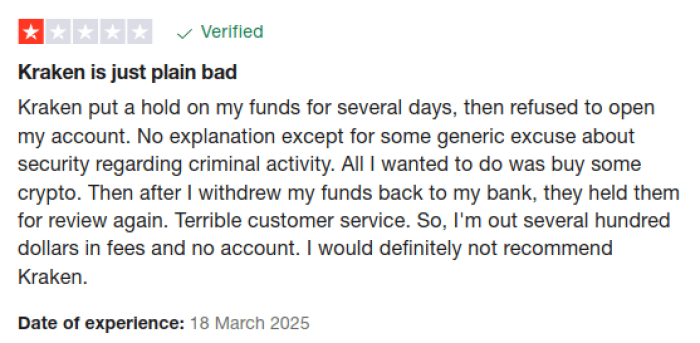
Also, many users confuse the exchange with the wallet, which are two distinct products. So, the exchange-related queries and ratings have also affected the wallet’s ratings.
We found some complaints regarding order executions, which, again, isn’t really Kraken’s fault, since it’s determined by market depth, volatility, and volume. The support team has diligently replied to all genuine complaints and queries on third-party review apps like Trustpilot.
It’s also worth noting that Kraken Wallet was only launched in April 2024. A lot of users are still figuring their way through the app, which is why you’ll find a lot of complaints on various forums.
Still, many users are happy with the wallet’s easy onboarding and speedy asset transfers.
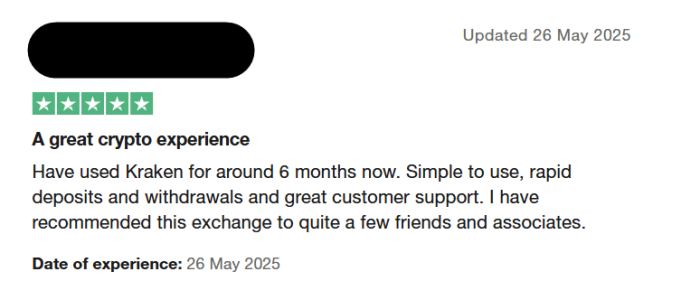
The public’s unfamiliarity notwithstanding, dissatisfaction with the customer service is a recurring theme in Kraken’s reviews.
In our own testing, whenever we found ourselves confused about any particular aspect of the app, we headed over to the settings and clicked ‘Support.’ That took us to Kraken’s website, which has a long list of FAQs and how-to guides. In most cases, this proved to be enough.
Unfortunately, though, we didn’t find an option to directly get in touch with a human agent (either through live chat or phone call), which is generally the first and last port of call for many users.
Although Kraken does have email customer service (this was down during our testing), it doesn’t compare to the likes of Margex Wallet, which offers 24/7 human assistance via live chat.
How to Use Kraken Wallet – A Step-By-Step Guide
Here’s a detailed guide on how to set up the Kraken Wallet and use its basic functions.
Step 1: Download the Wallet App or Set it up Via the Kraken Website
Download the Kraken Wallet app and create a new wallet to get started. Click on ‘Create Account’ to start the process. The app will ask you to back up your wallet – either manually or on the cloud. Choose what suits you the best.
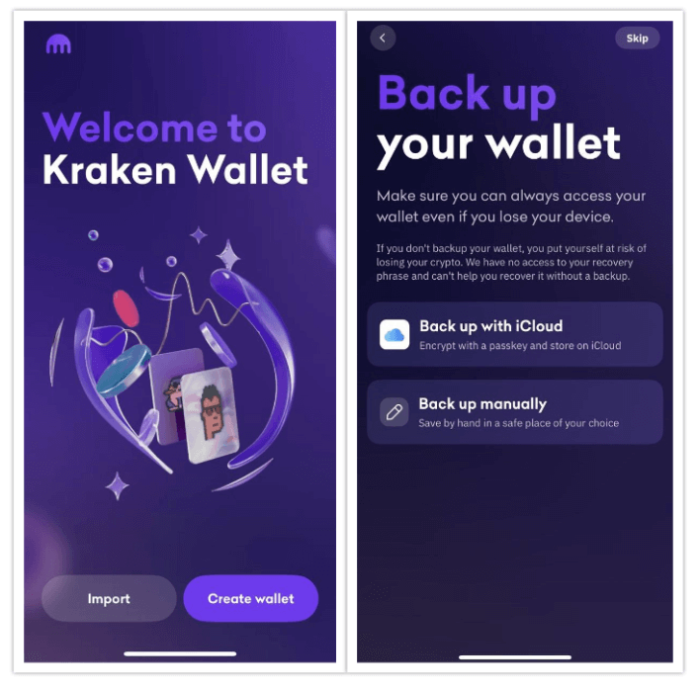
Step 2: Backup Your Recovery Phrase
Next, you’ll be shown 12 recovery words in a specific numerical order. This is your Secret Recovery Phrase. Make sure you note these down in the specified order.
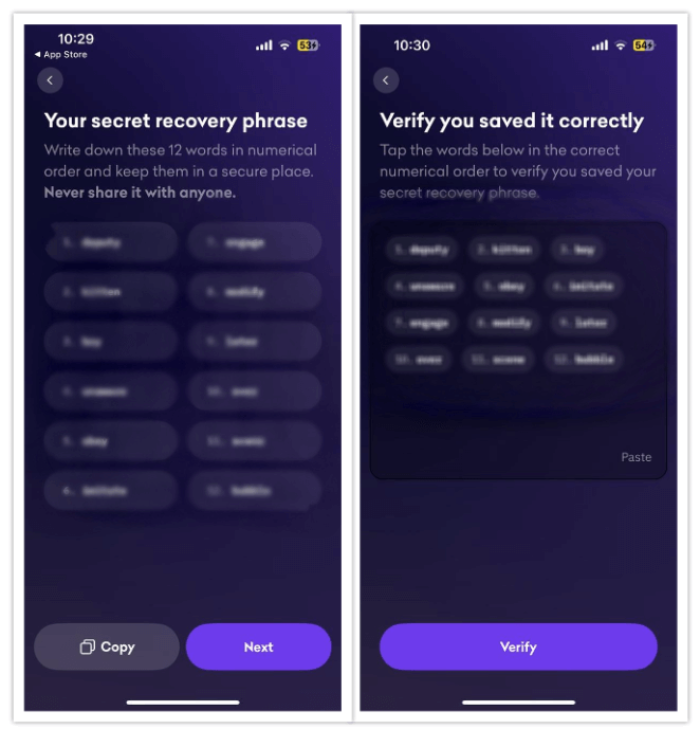
On the next screen, you’ll be required to enter these words correctly so that Kraken knows you’ve saved them. Ensure you save them in a secure storage (like an encrypted notes app), as you’ll lose your account if you lose these phrases.
Step 3: Send and Receive Crypto Assets Within the Wallet
Your account is now ready, meaning you’re all set to send and receive crypto on Kraken Wallet. To send crypto, click the ‘Send’ icon at the top of your app’s home screen.
Then, enter the recipient’s wallet address or scan the wallet code. After this, enter the amount of crypto you want to transfer and complete the transaction.
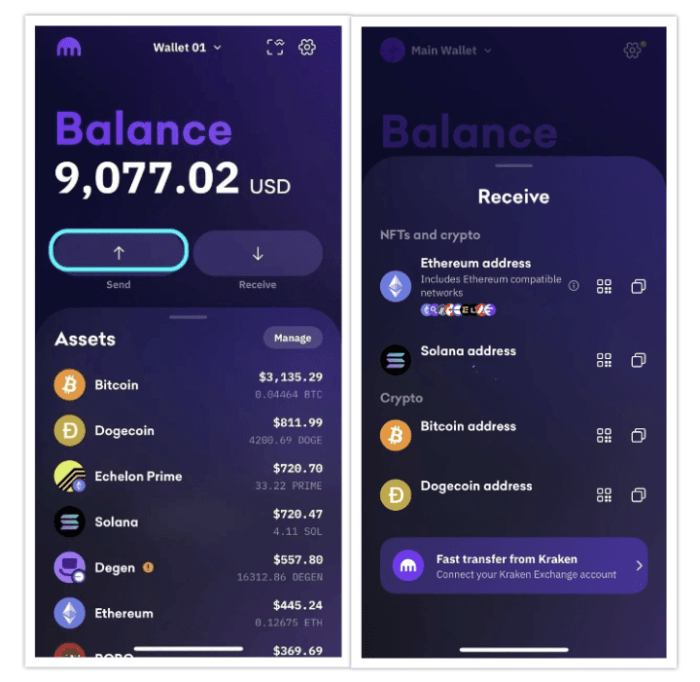
To receive crypto, click on ‘Receive’ and then identify which address you want to copy or share, which will depend on the asset you want to receive. You can either copy the address and send it manually to the sender or click on the QR code icon to share it automatically.
Kraken Wallet Review – Final Thoughts
Kraken Wallet is an easy-to-use, self-custodial, and multi-chain crypto wallet that lets you send, receive, and swap cryptos in a secure and effortless manner.
Currently, it allows access to eight blockchains. These include Bitcoin, Ethereum, Solana, and Dogecoin, as well as Layer-2 blockchains such as Arbitrum, Base, Optimism, and Blast.
Security is a strong point, too. In addition to ensuring self-custody, the wallet also uses advanced encryption, 2FA, and biometric access to protect your account.
Also, the wallet is free to use, and you only have to pay the network fee, which is standard across all wallets. However, Kraken is not without its downsides.
For starters, it doesn’t support as many chains as its top competitors. Also, while not a dealbreaker, it lacks some features (i.e., fewer NFT management options) found on other wallets.
Overall, though, Kraken is a solid choice for those who value ease of use, security, and seamless integration with one of the best crypto exchanges.
FAQs
1. Is Kraken Wallet Safe?
Yes, Kraken Wallet is one of the safest crypto wallets. It employs two-factor authentication and biometrics at the device (local) level to ward off any unauthorized access. All information collected and stored by Kraken is also encrypted at both the data and system levels.
Plus, it integrates directly with the Kraken CEX, which conducts regular proof-of-reserves audits, confirming that it maintains over 100% reserve for all of its assets.
2. Can I Use Kraken Wallet for Trading?
Yes, you can use the Kraken Wallet for trading. All you have to do is integrate it with your Kraken exchange account.
This makes fund transfer a lot quicker when compared to connecting a third-party wallet with the exchange. There’s no deposit fee (only any applicable network fee and a small withdrawal fee).
If you’re an advanced trader, you’ll have the liberty to connect the Kraken Wallet with your Kraken Pro account.
3. How Do I Recover My Kraken Wallet If I Lose Access?
When you set up your Kraken Wallet, you’ll be given a 12-word Secret Recovery Phrase (SRP) in a specific order. You’ll need to note this down; you won’t be able to recover your wallet without this information.
To recover your wallet, download the Kraken Wallet app again and click ‘Import Wallet.’ Then, enter your SRP, choose the wallet you want to recover, and follow the on-screen prompts to confirm.

